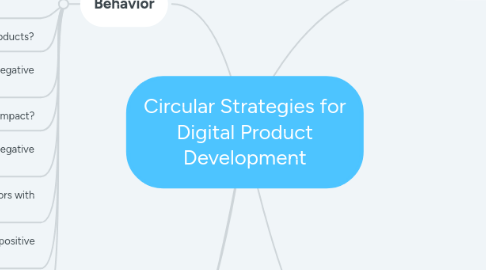
1. Product as a Forest
1.1. Does your product contribute to a sustainable, just, equitable civilization on earth?
1.1.1. Wealth accumulation
1.1.2. Replacing human jobs
1.1.2.1. More efficiency leads to income inequality
1.2. Is the planet a better place with or without your product?
1.3. can you increase society's chance to reach the SDGs with your product?
2. Systemic Impact
2.1. Which of the UN Sustainable Development Goals does your product support?
2.2. Which of the UN Sustainable Development Goals does your product hurt?
3. Behavior
3.1. Can you include positive reinforcement on your product?
3.1.1. What positive behavior is already present?
3.1.2. How might you create more of it?
3.1.3. Can you reinforce sustainable behavior with your product?
3.2. Does your product make the consequences of energy usage clear?
3.2.1. Could you make the positive aspects of saving energy clearer?
3.3. Does your product promote acquiring more physical goods?
3.4. Does your product make it easier to acquire more physical goods?
3.5. focus on local economy?
3.6. substitute a product with less positive / more negative impact?
3.7. promote re-use of physical products?
3.8. change existing behavior to less negative impact?
3.9. add new behavior with positive impact?
3.10. help to end behavior with negative impact?
3.11. empower users to embrace behaviors with less negative impact?
3.12. can you measure the relative positive impact of your product?
3.13. promote relatively less or absolutely less negative impact?
4. Technology & Energy
4.1. Does your product require a powerful device to run on?
4.2. On a mobile device, does your product use a lot of battery power?
4.2.1. Can you change the architecture to consume less battery power?
4.3. Are you actively keeping the devices your product runs on from becoming obsolete?
4.3.1. Does your product support older operating system versions, so older devices do not become obsolete?
4.3.1.1. Could you change the architecture / technology stack to accommodate older OS versions?
4.3.1.2. Could you add testing on older devices and OS versions?
4.3.2. Does your product support older screen resolutions?
4.3.2.1. Can your UI support low resolution devices?
4.3.2.2. Can your UI support smaller screen sizes on mobile devices?
4.3.3. Can you test on older devices, so they will remain current for supporting your product?
4.3.4. Can you build your product independent of the latest OS APIs?
4.4. Does the energy your product requires server-side have a secondary use (e.g. heating)? If not, could you add it?
4.5. Can the energy flows needed for the use of your product be made more efficient?
4.5.1. Could your product "hitch a ride" with something else that consumes energy anyway?
4.6. Does your product depend on energy-intensive technologies?
4.6.1. Do you utilize cryptocurrencies?
4.6.2. Could you achieve your product goals without using cryptocurrencies?
4.7. Optimize web tech for energy efficiency
5. Wealth, Equality & Consumption
5.1. Does your product increase income levels in subsistence-level income areas / groups?
5.1.1. Raising invome groups beyond subsistence levels creates more equality, yet empirically also often creates harmful consumption patterns, e.g. in meat consumption.
5.1.2. Can you create more equality without fueling harmful consumption patterns, e.g. by creating helpful habits at the same time?
